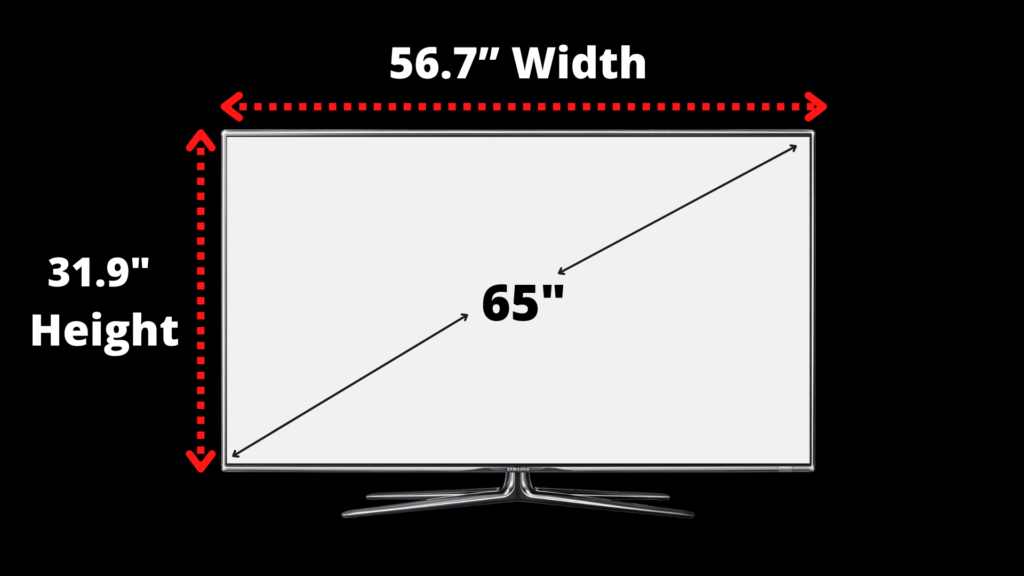How Wide is a 65-Inch TV?

Today, there are seemingly endless options when it comes to buying a television. Top brands such as Samsung, Sony, LG, Vizio, TCL, and Phillips, all sell 65” TVs at 4K and 8K resolutions. Each brand has its own unique features and varies in price, so you’ll want to do a bit of research before spending a good amount of cash.
While the dimensions of 65-inch TVs vary within the different models, in general, a standard 65” TV is 56.7” in width or almost five feet. This is a medium-to-large sized TV perfect for a living room or group setting, as it’s big enough to cater to multiple people.
To learn more about the differences between currently available 65” TVs, continue reading below.
Standard Width Chart for TVs
Below you’ll find the standard widths for available TVs. The size refers to the diagonal distance of the screen from the bottom-left corner to the top-right corner, while the width refers to the distance from either side of the TV.
| Size (inches) | Width (inches) |
| 32” | 27.9” |
| 40” | 34.9” |
| 43” | 37.5” |
| 50” | 43.6” |
| 55” | 47.9” |
| 60” | 52.3” |
| 65” | 56.7” |
| 70” | 61” |
| 75” | 65.4” |
| 80” | 69.7 |
| 85” | 74.1” |
What TV Width Should You Choose for Your Home?
Choosing the right width depends on the size of your room/display center, how many people you’re looking to entertain, and your budget. Fortunately, most televisions available today are almost exclusively sold at 4K resolution, which refers to a horizontal display of 4,000 pixels, for a total of nearly 8 million pixels. That means that even the smallest 4K TVs offer a precise quality resolution. It takes a very large TV to see imperfections at 4K.
When it comes to TV sizes, bigger isn’t always better. Human eyesight has a total horizontal field view of around 200°, which includes your peripheral vision. When it comes to watching TV, it’s recommended that your screen fills up about 30° of your field of vision for the best experience. Of course, you’re probably not going to measure the exact angles at which you’re watching TV, so we recommend something between a 50” and 70” TV for the best home viewing experience. If you go bigger than that, it’s actually harder to watch TV (especially sports), due to the wide-angle.
What Are The Different Types of TV Displays?
There are three main TV displays: OLED, QLED, and LED. Each refers to a different type of panel technology and how the TV is illuminated.
What is LED?
LED stands for “light emitting diode”, which is a fancy term to explain how the TV gets its brightness. LEDs use a backlight instead of fluorescent tubes, allowing these TVs to be thinner and more energy-efficient. Some LED TVs only use the backlighting on the sides, while others use a full-array grid. The only downside to LEDs is that it can make the image appear washed out, but many new technologies use full-array local dimming, which allows the TV to dim specific areas of the content.
LED TVs offer the best value, as they typically aren’t as expensive as OLED and QLED.
What is QLED?
LED and QLED TVs are fairly similar, however, QLED uses a quantum dot layer in between the backlight and LCD panel to produce a wider range of color. This extra layer produces brighter colors that are more saturated than your traditional LED TV. The quantum dots also resist moisture well, which means your QLED TV will last long. The only downside is that you might experience some light bleed in particularly bright scenes or around bright objects. This can cause a subtle blur, reducing sharpness.
What is OLED?
OLED (organic light-emitting diode) TVs are completely different from LED and QLED. These TVs do not use a backlight, but instead have millions of self-illuminating pixels. OLED TVs adjust the brightness of each pixel individually, which makes for near-infinite contrast and depth. They can also turn off their pixels completely to show pure, inky blacks. OLED TVs are also great for wide viewing angles and have the best contrast ratio.
Benefits of a 65-inch Samsung TV
Curved Screen TV
Samsung is one of the top electronic manufacturers in the world, and their TVs certainly aren’t cheap. They are known for their unique, curved screen that provides a wide-angle view. The purpose of the curved screen is to make the viewing experience feel more natural, since it mirrors the shape of your eye. This panoramic viewing experience makes it an attractive option.
Anti-Glare Technology
Technology gets its best cues from nature, and Samsung’s QLED TVs are no different. Its anti-glare technology is based on the structure of a moth’s eye with its microscopic bumps and grooves. This texture absorbs reflected light, significantly reducing reflections and glare on the TV screen.
Shop for Samsung 65” TVs here.
Benefits of a 65-inch TCL TV
Affordable Price
TCL is the second-largest retailer of television sets in the world. This Chinese conglomerate is known for making quality TVs at affordable price tags. If you want the most bang for your buck and aren’t looking to drop thousands of dollars, TCL TVs are your best choice.
Android Operating System
TCL smart TVs are Android-friendly, which means you can use the Android interfaces and app libraries. You can also connect your TCL TV to your smartphone or Google Home, allowing you to operate the TV via Google Assistant voice commands.
Shop for TCL 65” TVs here.
Benefits of a 65-inch LG TV
Premium OLED Experience
The LG OLED TVs are some of the best rated, because they offer premium features and extraordinary performance. The LG G1 OLED boasts self-lit pixels and the Alpha 9 Gen 4 processor, which work together for unbeatable picture quality that produces perfect black and accurate color. You’ll notice extreme realism thanks to the self-lit pixels. LG has become known for their OLED TVs, because they were the first brand to widely distribute these TVs.
Best TV for Gaming
The LG OLED C1 Series 65” Alexa Built-in 4k Smart TV was rated 2022’s “Best Overall” TV for gaming by Variety. This TV has a “Game Optimizer” mode, which produces fast response times and minimizes input lag. It also has a 120Hz refresh rate, which is the best possible refresh rate for gaming. With multiple input jacks and a Bluetooth connection, you can’t go wrong with this TV by LG.
Shop for LG 65” TVs here.
Benefits of a 65-inch Sony TV
Upscaling Lower Resolution Content
Sony TVs come at a premium price, but they have some unique differentiators that make their TVs stand out. Sony does an excellent job at upscaling lower-resolution content, which means that it can take low-res video content (less pixel count) and match it with that of a higher-resolution TV screen. This improves viewing quality, as the picture can now fit a higher resolution screen.
Superb at Motion Handling
TV manufacturers work to reduce motion blur by inserting black frames into the video signal, or using repeating frames. This gives your picture a smoother, more natural display. Sony uses Motionflow XR technology, which refreshes each frame at an extremely high rate. As a result, that football touchdown or high-speed car chase looks crystal clear, instead of blurred by motion. This is also super helpful for gaming, as there’s a greatly reduced input lag.
Great Color Accuracy
Sony is known for having excellent color right out of the box, so you don’t need to get your TV calibrated. Most TVs have slight color inaccuracies that aren’t noticeable to the naked eye, while some need to be adjusted because the color feels off. Sony’s white balance, gamma, and color temperature rarely need to be adjusted, if ever.
Shop for Sony 65” TVs here.
Benefits of a 65-inch Vizio TV
Competitive Pricing
One of the more affordable TV manufacturers, Vizios are usually several hundred dollars cheaper than the competition. You can get a 65” Vizio TV for less than a thousand dollars, which is rarely the case for brands like Sony or Samsung.
Great Picture Quality in the Dark
Vizio TVs can display some of the deepest, inky blacks in a dark room. Their OLED TVs can turn pixels off individually, which creates a deep contrast. You won’t see that distracting blooming around bright objects or subtitles, and it has an incredible ability to handle glare, so you don’t get any reflection.
Long-term Smart TV Support
One of the most frustrating things about updating technology is that you constantly have to buy new software or buy separate accessories and plug-ins. However, Vizio eliminates that problem by keeping all of its SmartCast TVs up to date. Since 2016, their SmartCast sets run on the same software and support all the same apps, including AirPlay 2 and Google Chromecast.
Shop for Vizio 65” TVs here.
Benefits of a 65-inch Philips TV
Proprietary Ambilight TVs
Almost all Philips TVs these days use their proprietary Ambilight technology, which drastically increases the contrast, color hues, and brightness. It’s right up on par with Sony or Samsung. Ambilight features intelligent LEDs around the side of the television, which project onto the walls and into the room. You’ll feel completely immersed in their light display, and it feels like the color is seeping out of the television itself.
Compatible with Android and Roku Operating Systems
Philips 65” Smart TVs work with both Android and Roku operating systems, two widely popular systems. With Android, this means you can use Google Assistant to navigate your TV and hook it up to your phone. Roku is one of the top-rated operating systems because it’s easy to use and has automatic software updates.





